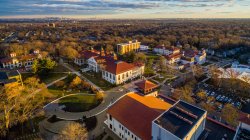Research Explores ‘Pockets of Peace’
Associate Professor of Public Health Tamara G.J. Leech is focused on shining a light in corners of communities too often left in shadow.
For years, Leech has devoted her research to the ways that neighborhoods in challenged communities can remain immune to violence and despair. Her work, “Pockets of Peace: Communities Resilient to Adolescent Violence,” focuses on uplifting news in Indianapolis, Indiana.
“We did the study in 127 one-block neighborhoods where residents faced a concentrated disadvantage in their circumstances, from a 35 percent poverty rate to high unemployment rates and a reliance on government programs,” Leech says. “Of these neighborhoods, 19 averaged less than one act of reported violence per year for each of the five years we were in the field.”

While her original five-year study ended in 2012, she has continued to research the topic and received a one-year grant in 2017 from the William T. Grant Foundation to further study what makes neighborhoods resilient.
Why Indianapolis? Leech says that roughly a decade ago, when the study began, Indianapolis outpaced Chicago in homicides. Through her work, she focused on a variety of assets, from churches and gas stations to the standing of “old heads,” longtime neighborhood residents who inspire young people to avoid self-destructive behaviors and focus on community.
“It is no surprise that the structural disadvantage that youth face in marginalized and underserved urban environments leads to violence,” Leech says. “But our study of these spaces gave us the opportunity to figure out in a realistic way how some entire neighborhoods thrive as ‘pockets of peace’ — resilient to the threat of violence.”
As part of the study, Leech gave iPhones to 28 young men in Indianapolis — 14 from neighborhoods that were “pockets of peace” and 14 from traditionally challenged neighborhoods — to talk with them weekly to gain their insights on life in their communities.
“We found that among these young men — even those who were engaging in violence — 100 percent wanted to continue completing their diaries in addition to sharing other things about their neighborhood.”
She hopes that other communities around the country will see these neighborhoods as examples to emulate. “We can make this strong argument that peace is possible everywhere,” she says, “despite conditions that are counterintuitive to it.”
